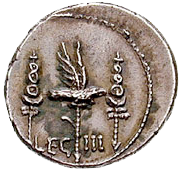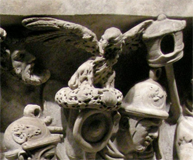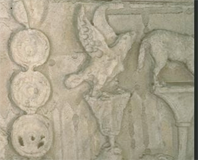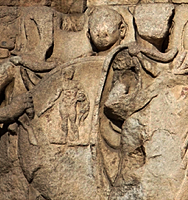
This page created 29 March 2014, and last modified: 28 November 2015 (Passio commentary added added)

In the western half of the empire, the second-most senior unit of the legiones palatina listed (98/9.22 in Ingo Maier's numbering scheme) in the Magister Peditum's infantry roster is the Herculiani seniores; it is assigned (102/5.55) to his Italian command. Its shield pattern (92#3), as shown in various manuscripts under the label (92.c) Herculiani (except O, which gives Herculiani sen.), is as below:

This pattern shows an unusual amount of variation between the various manuscripts, not aided by my suspicion that the Froben imprint may have this pattern swapped with that of the adjacent Ioviani seniores (98/9.21), which also shows significant variations from manuscript to manuscript. It is one of a set of four very similar patterns, belonging to the Ioviani seniores, Herculiani seniores, Ioviani iuniores (9.18), and the Herculiani iuniores (9.19), with the two paired iuniores units being in the east, under the command of the first Master of the Soldiers in the Imperial Presence, and the two paired seniores units in the west under the Magister Peditum. The patterns shown below taken from the Paris manuscript clearly show this relationship:

What is being shown here is probably not an eagle, as such, but the image of a legionary standard in the form of an eagle, since the images of the two iuniores units show clear signs that they are standards (having a wreath held in the eagle's beak in the case of the Ioviani iuniores, and being mounted on a short cross-bar, in the case of the Herculiani iuniores).
Legionary eagle standards seemed to have taken a variety of forms. Below left is that of Legio III Cyrenaica, as depicted on a denarius of Marcus Antonius struck in 32 BC (picture from http://www.cngcoins.com under CCA 3.0 license). In the middle is that of Legio IIII Flavia from the Portonaccio Sarcophagus of ca. 190 AD (picture from National Museium of Rome under CCA 3.0 license). On the right is that of Legio I Minerva, from Trajan's column (picture by Peter Rockwell, and taken from www.stoa.org).



Unfortunately no legionary aquila has survived to the present day, although a non-legionary Roman eagle has been recovered from Silchester in Britain, minus its wings.
Grigg in a 1979 paper opined that although the "Iovii and Ioviani, for example would be appropriately represented by some form of eagle" (the eagle being an attribute of Jupiter), he stated that the fact that the Herculiani iuniores was also represented by an eagle, and not by a figure of Hercules, was prima facie evidence its pattern as depicted in the Notitia was in error. In a follow-up paper he repeated the claim that a unit named after Hercules should feature either "Hercules or one of his well-known attributes" as its shield pattern, but provided no basis for this bare assertion, and there are powerful arguments against it (see further below).
It should be noted, however, that the original Herculiani legion was a Tetrarchic creation of the last quarter of the 3rd century and the Arch of Galerius (one of the Tetrarchs), shows two shield patterns that apparently belong to the original Ioviani and Herculiani units: one shows an eagle, while the other, as depicted below, shows Hercules, readily identifiable by his club and lion skin.

Thus the usage of Hercules as a shield pattern motif in the context of the late 3rd-century is secure. But that does not mean it should have been so 100 years later. The evidence of the Notitia is that this exact shield pattern was no longer in use by the time of its compilation. One important advantage of showing each unit's standard as its shield pattern, as opposed to its titular deity, would have been that the clearly pagan image of Hercules would not need to be shown in an increasingly Christianised military hierarchy.
This is borne out by the Passio Sanctorum Bonosi et Maximiliani, a tale of two Christian standard bearers serving in the Iovianiand Herculiani seniores in 362 who were said to have been executed for refusing to remove the Christian elements of their standards during the reign of Julian the Apostate and restore the formerly used pagan ones. Indeed, it would appear that the Herculiani seniores bore an image of Hercules as a standard until the reign of Constantine the Great, and that it reverted to this form in Julian's reign, and apparently was still in this form during Eugenius' usurpation in 392-394. Singular standards are of course easier to replace than a thousand or more shields, so it is entirely possible that the unit may have abandoned an image of Hercules as a shield pattern during Constantine's reign and never reverted to it.
The Passio Sanctorum Bonosi et Maximiliani is notable as also being a very rare reference to a seniores unit predating 364. When the original Ioviani and Herculiani legions were split into seniores and iuniores units is unknown, but they were clearly so split by Julian's time at the latest.
1. Ingo Maier; "Appendix 4: Numeration of the new edition of the compilation 'notitia dignitatum' (Cnd)"; last accessed 26 October 2015. See also for here for numbering examples. Return
2. Robert Grigg; "Portrait-Bearing Codicils in the Illustrations of the Notitia Dignitatum?"; The Journal of Roman Studies, Vol. 69 (1979), pp 107-124. Return
3. Robert Grigg; "Inconsistency and Lassitude: The Shield Emblems of the Notitia Dignitatum"; The Journal of Roman Studies, Vol. 73 (1983), pp 132-142. Return
4. David Woods; "Ammianus Marcellinus and the Deaths of Bonosus and Maximilianus"; Hagiographica, 2 (1995), pp 25-55. Return
5. David Woods; "Julian, Arbogastes, and the signa of the Ioviani and Herculaiani"; Journal of Roman Military Equipment Studies, 6 (1995), pp 61-68. Return
6. That the legion bore a standard in the form of Hercules in no way prevents it from sumultaneously having born another standard bearing an eagle. It is clear Roman units had multiple standards, as the profusion of ranks named after the standards they bore attests: aquilifer, imaginifer, signifer, draconarius, vexillarius. Return

Return to the Notitia alphabetical unit list page.
Return to my Notitia index page.